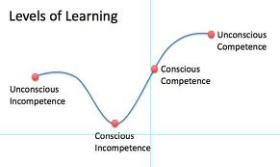The current news on employment may scare you, but there is no dearth of fresh recruits across Industries. Fresh recruits are growing by an average of 25% yoy and to make them ready, training forms the core. New recruits are like rubber; you can mold and develop them as per your or the requirement. They are ready to learn and keen to show their talent and ability. As the saying goes ‘hit the iron when it is hot’, the new recruits should be trained when they are willing to learn.
As explained in Wikipedia, “In psychology, the four stages of competence or the conscious competence” learning model, relates to the psychological states involved in the process of progressing from incompetence to competence in a skill.”
The “Four Stages of Learning New Skill” was developed at the Gordon Training International in the 1970’s. Today few organizations implement this methodology to train their employees. If used properly, the method will bring pay high dividends in helping individuals learn new concepts. In this blog, we will look at each competence and how well we can implement them to achieve maximum results.
The First Level: Unconscious Incompetence
Let me state this by an example: Consider it has never occurred to you that you should learn to drive. There was no need for you to do so. This stage is Unconscious Incompetence. You do not realize that you are not competent or you don’t have the necessary skill to drive.
Fresh Recruits before they are placed in any organization are in this stage. They are not aware that they do not have the necessary skill to execute. This is because they are yet to be placed and are free birds at the moment. We do not have an impact in this stage.
The Second Level: Conscious Incompetence
Carrying from the above example, consider that now you are required to learn how to drive. In this stage emotions such as fear/excitement/concerns occur. Here you realize that you have to learn something new. The emotional state of every individual varies.
Fresh Recruits are in this stage. They sit in the training room with varied thoughts. They are worried whether they are competent, whether they will be able to learn, what will happen if they can’t learn, whether others are more competent etc. Some, they experience positive thoughts but majority experience negative thoughts.
This stage is critical since this is when the trainer sets the tone for the training program. The program should contain modules that will break the ice, help people mingle with each other, share their personal details and feel comfortable. They need to feel at home. No products, process, company details are shared at this stage. This stage is pure fun and may require couple of hours or half- a- day depending on the audience size.
The Third Level: Conscious Competence
From the example, now that you have learned the basics, you are now aware that you are (now) competent. You relax, shift gears and drive. However you are still aware of your gear, controls, traffic and your driving methodology.
Your participants now develop their confidence. The stage is marked by introduction to company, products, services and other matter. Theories are downloaded, explained and demonstrated. This stage should have lot of exercises; activities related to the learning topic, quiz (not test), role play & teamwork. People learn when they participate.
The fourth Level: Unconscious Competence
Continuing with the example, now you are not aware that you are changing gears. You do things smoothly and feel at home.
From the above stage, the participants have gained confidence to display their learning. They now do things automatically without being consciously aware of what they are doing. Tests, Q&A and other activities will enable the participant to reach this stage.
Note that the second and third stages form the critical aspect of any training program. Don’t assume that a fresher ‘knows’. Treat them as you would treat a small child. Your training methodology at the second level should be of the same standard as how you would teach a child alphabets and words. In the third stage you become a high school teacher and guide participants. In the final level, you change to an one who evaluates.
If you find any participant struggling to cope up with the learning, you take them separately and start all over again. With the process in place, you will develop quality employees ready to take on tasks.


Good one Srikkanth. Way to go on ..Training
Thanks Buddy.